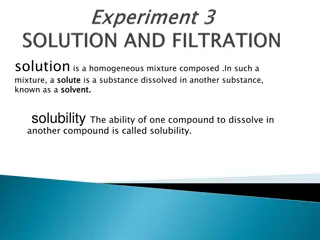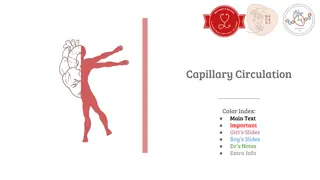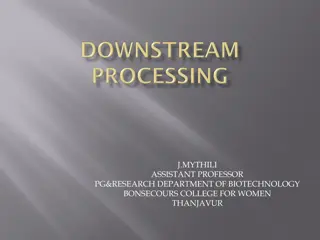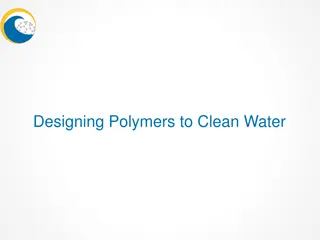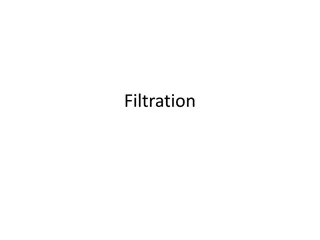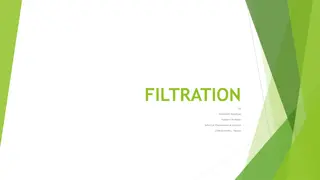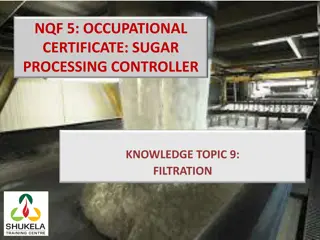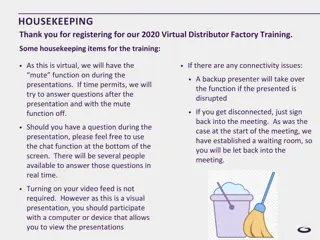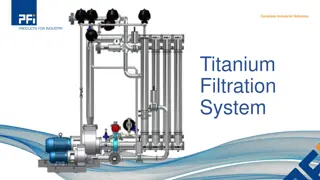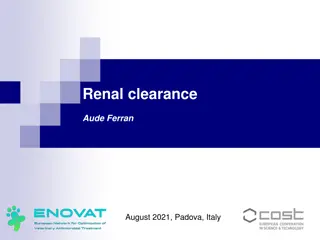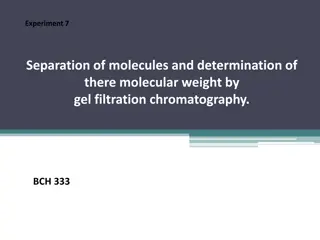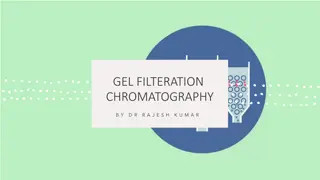Understanding Filtration Process in Industrial Operations
Filtration, a crucial unit operation, involves separating solids from liquids by passing them through a porous medium. This process is essential in industries like oil refining, beer production, and fruit juice processing. Filtration can be categorized into cake filtration, clarification, and cross-flow filtration, each serving different purposes based on solid content and desired product. Equipment like Microfiltration (MF) and Ultrafiltration (UF) are increasingly used for efficient industrial filtration.
Download Presentation

Please find below an Image/Link to download the presentation.
The content on the website is provided AS IS for your information and personal use only. It may not be sold, licensed, or shared on other websites without obtaining consent from the author. Download presentation by click this link. If you encounter any issues during the download, it is possible that the publisher has removed the file from their server.
E N D
Presentation Transcript
Filtration Dr. Sevim KAYA 1
FILTRATION Filtration is a unit operation in which a mixture of solids and liquid called the feed or the suspension or the slurry or the influent or the dispersion is forced through a porous medium in which the solids are deposited or entrapped. The porous filter medium is the permeable material that separates particles from liquids and is known as the filter. The solids retained on the filter are called the residue. The solids form a cake on the surface of the medium and the clarified liquid known as effluent or filtrate is discharged from the filter. As the solids are removed from the fluid, they accumulate in the filter medium, resulting in an increased resistance to flow as the filtration process continues. All these factors result in a description of filtration rate 2
Filtration Filtration involves the removal of insoluble particles from a suspension by passing it across a porous material, retaining particles according to their sizes and shape to some extent. As the filter media retain the larger particles and form a filter cake , the permeate passes through the filter barrier. The mean size particles and their distribution will both have a great influence on the type of filter used. 3
Flow of filtrate Gravity: very free-draining solids or very low solids content Pressure (upstream) Vacuum (downstream) Centrifugal force 7
Filtration processes can be broadly classified into three categories. If recovery of solids is desired, the process is called cake filtration. Insoluble solids >1-2% by wt The term clarification is applied when the solids do not exceed 1 % w/w and the filtrate is the primary product. The third type of filtration is called cross-flow filtration in which the liquid flows in a tangential direction with respect to the filtration medium. Crossflow filtration is mainly used for membrane filtration (microfiltration). In this section only cake filtration will be discussed. 8
Filtration equipments are mainly used in edible oil refining, sugar refining, beer production, wine making, and fruit juice processing. The uses of Micro filtration (MF) and ultra filtration (UF) for those latter applications are increasing, as more efficient industrial equipment and membranes become available 9
Filtration Equipment The basic requirements for filtration equipment are: mechanical support for the filter medium, flow accesses to and from the filter medium and provision for removing excess filter cake. In some instances, washing of the filter cake to remove traces of the solution may be necessary. Pressure can be provided on the upstream side of the filter, or a vacuum can be drawn downstream, or both can be used to drive the wash fluid through. 10
Bed or Depth filters Depth filter is one where the solids take the space of the pores instead of forming cakes on the surface. Sand filter is a common type of depth filter used to purify water. It is suitable for filtration of suspension with less solid concentration. The sand is filled from the bottom in pattern of decreasing size. Flocculants are usually added to water before filtration. The filtration continues till the solid particles fill the sand pores. Back washing is possible only when the suspended particles are non-adhesive to the sand particles. Sand, charcoal not so common for food ind, cotton, silk, wool, nylon having suitable pore sizes for specific purposes) 11
Plate and frame filter press In the plate and frame filter press, a cloth or mesh is spread out over plates which support the cloth along ridges but at the same time leave a free area, as large as possible, below the cloth for flow of the filtrate. The plates with their filter cloths may be horizontal, but they are more usually hung vertically with a number of plates operated in parallel to give sufficient area. Filter cake builds up on the upstream side of the cloth, that is the side away from the plate. In the early stages of the filtration cycle, the pressure drop across the cloth is small and filtration proceeds at more or less a constant rate. As the cake increases, the process becomes more and more a constant-pressure one and this is the case throughout most of the cycle. When the available space between successive frames is filled with cake, the press has to be dismantled and the cake scraped off and cleaned, after which a further cycle can be initiated. The plate and frame filter press is cheap but it is difficult to mechanize to any great extent. Variants of the plate and frame press have been developed which allow easier discharging of the filter cake. For example, the plates, which may be rectangular or circular, are supported on a central hollow shaft for the filtrate and the whole assembly enclosed in a pressure tank containing the slurry. Filtration can be done under pressure or vacuum. The advantage of vacuum filtration is that the pressure drop can be maintained whilst the cake is still under atmospheric pressure and so can be removed easily. The disadvantages are the greater costs of maintaining a given pressure drop by applying a vacuum and the limitation on the vacuum to about 80 kPa maximum. In pressure filtration, the pressure driving force is limited only by the economics of attaining the pressure and by the mechanical strength of the equipment. 12
Filtration equipment: (a) plate and frame press (b) rotary vacuum filter (c) centrifugal filter 13
Rotary filters In rotary filters, the flow passes through a rotating cylindrical cloth from which the filter cake can be continuously scraped. Either pressure or vacuum can provide the driving force, but a particularly useful form is the rotary vacuum filter. In this, the cloth is supported on the periphery of a horizontal cylindrical drum that dips into a bath of the slurry. Vacuum is drawn in those segments of the drum surface on which the cake is building up. A suitable bearing applies the vacuum at the stage where the actual filtration commences and breaks the vacuum at the stage where the cake is being scraped off after filtration. Filtrate is removed through trunnion bearings. Rotary vacuum filters do provide a considerable degree of mechanization and convenience. A rotary vacuum filter is illustrated diagrammatically in Fig. 10.8(b). 17
Centrifugal filters Centrifugal force is used to provide the driving force in some filters. These machines are really centrifuges fittedwith a perforated bowl that may also have filter cloth on it. Liquid is fed into the interior of the bowl and under thecentrifugal forces, it passes out through the filter material. This is illustrated in Fig. 10.8(c). Air filters Filters are used quite extensively to remove suspended dust or particles from air streams. The air or gas movesthrough a fabric and the dust is left behind. These filters are particularly useful for the removal of fine particles.One type of bag filter consists of a number of vertical cylindrical cloth bags 15-30 cm in diameter, the air passingthrough the bags in parallel. Air bearing the dust enters the bags, usually at the bottom and the air passes outthrough the cloth. A familiar example of a bag filter for dust is to be found in the domestic vacuum cleaner. Somedesigns of bag filters provide for the mechanical removal of the accumulated dust. For removal of particles lessthan 5 mm diameter in modern air sterilization units, paper filters and packed tubular filters are used. These coverthe range of sizes of bacterial cells and spores. 19
Rotary vacuum drum filter Rotary vacuum drum filter (RVDF), patented in 1872,[2]is one of the oldest filters used in the industrial liquid-solids separation. It offers a wide range of industrial processing flow sheets and provides a flexible application of dewatering, washing and/or clarification. A rotary vacuum filter consists of a large rotating drum covered by a cloth. The drum is suspended on an axial over a trough containing liquid or solids slurry with approximately 50-80% of the screen area immersed in the slurry. As the drum rotates into and out of the trough, the slurry is sucked on the surface of the cloth and rotated out of the liquid or solids suspension as a cake. When the cake is rotating out, it is dewatered in the drying zone. The cake is dry because the vacuum drum is continuously sucking the cake and taking the water out of it. At the final step of the separation, the cake is discharged as solids products and the drum rotates continuously to another separation cycle 24
Drum filter 25
Advantages and limitations The advantages and limitations of rotary vacuum drum filter compared to other separation methods are: Advantages The rotary vacuum drum filter is a continuous and automatic operation, so the operating cost is low. The variation of the drum speed rotating can be used to control the cake thickness. The process can be easily modified (pre-coating filter process). Can produce relatively clean product by adding a showering device. Disadvantages Due to the structure, the pressure difference is theoretically limited to atmospheric pressure (1 bar), and in practice somewhat lower. Besides the drum, other accessories, for example, agitators and vacuum pump, vacuum receivers, slurry pumps are required. The discharge cake contains residual moisture. The cake tends to crack due to their air drawn through by the vacuum system, so that washing and drying are not efficient. High energy consumption by the vacuum pump. 26
Filter aids Filtration aids, such as diatomaceous earth, cellulose or charcoal, are often used as absorbents to control the formation and the properties of the filter cake, in order to prevent resistance to fluid flow 28
Filter aids: very fine particles having highly compressible character tends to block filtrate quickly, shortens the runs. They forms a rigid structure in the medium and provides numerous channels through which the filtrate can flow thus showing the blocking and prolonging the filtration cycle. Filter aids are slimy or very fine solid that form an impermeable & dense cake. It increases the porosity of cake and filtration occurs at reasonable rate. Precoating of filter are also used on medium and scraped off in regular interval. It prevents the plugging of medium by gelatinous solids. 29
Mechanism of filtration The driving force for filtration is pressure difference across the medium. Generally the pressure at upstream (above filter medium is at atmospheric pressure and that at the downstream (below filter medium) is vacuum. The pressure above atmospheric pressure can be created by using pump, blower or centrifugal force to increase the efficiency of the separation process. The filter medium offers the resistance to flow. Hence as the solids deposited on the filter medium forms cake and resistance starts increasing. The solid particles block the opening of filter medium. The analysis of filtration is largely a question of studying the flow system. The fluid passes through the filter medium, which offers resistance to its passage, under the influence of a force which is the pressure differential across the filter. Thus, we can write the familiar equation: rate of filtration= driving force resistance 30
Filtration Filtration rate depends on several other factors, including The pressure drop across the filter medium The area of the filtering surface The viscosity of the filtrate The resistance of the filter cake as determined by the solids removed from the fluid The resistance of the filter medium. 31







